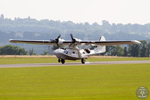IWM Duxford-based Catalina takes on a round-Britain challenge
On Wednesday 21 August, Catalina G-PBYA, operated by Plane Sailing Air Displays Limited and based at IWM Duxford, started on a remarkable aviation challenge.
Honouring the daring flying expeditions of the pioneer aviators, the Catalina undertook, in its centenary year, the 1913 Circuit of Britain flight, which was flown by pilot Harry Hawker and mechanic Harry Kauper, both Australians, in a Sopwith Waterplane.
The Catalina celebrates its 70th birthday this month, making it the oldest UK-based airworthy amphibian.
The 2013 Catalina commemoration was led by pilot Jeff Boyling, who, like Harry Hawker, was born in Australia and shares a passion for aeronautical adventure. By marking this occasion, Jeff hopes to inspire younger generations with the wonder of flying and to keep the golden era of aviation alive today.
Jeff said prior to the start of the adventure: “Flying the Catalina G-PBYA is a huge privilege and honour. It is wonderful that this historic aircraft can pay tribute to a great aviator who was a real pioneer. May the memory of Hawker live on."
While the airspace in 2013 is somewhat more restricted then 100 years ago, the crew of the Catalina intended to follow the 1913 route as closely as possible.
The crew took off from IWM Duxford on Wednesday 21 August to complete the 1600 mile route over five days. They flew over some key historic sites, including Kingston, where the Sopwith Factory was based; Hook in Chessington, where Harry Hawker is buried and Brooklands Aerodrome (now Brooklands Museum), where Harry Hawker learnt to fly and tested aircraft for use in the First World War.
The Catalina also orbited the Classic Boat Museum at Cowes, which has on display a 1/8 scale replica of the Bat Boat tested by Harry Hawker in 1913.
The Catalina crew succeeded where Harry Hawker and Harry Kauper did not!
At 4.36pm today, Sunday 25 August, Catalina G-PBYA, operated by Plane Sailing Air Displays Limited and based at IWM Duxford, landed back at IWM Duxford.
 |
 |
 |
 |
 |
 |
 |
Having landed at IWM Duxford, pilot Jeff Boyling, who led the 2013 Circuit of Britain flight, was enthusiastically greeted by his wife and family.
 |
 |
 |
 |
Asked for his reaction on completing the historic flight, Jeff said: “Fantastic! It’s fantastic that we’ve achieved what we set out to achieve. The Circuit of Britain has been accomplished 100 years after Harry Hawker set out to complete it. We’re delighted that the Catalina has raised awareness of IWM Duxford across the country and has also highlighted the importance of the Royal Air Force Benevolent Fund.”
On the journey itself, Jeff said: “I’d like to pay tribute to Catalina captains Rod Brooking and John Warman, crew chiefs Sean Jarvis and David Legg and to Gary Short who saved the day in Oban by driving up and bringing essential parts for maintenance on the aircraft which meant that we could complete the flight. I’d also like to thank the shareholders of the Catalina for letting me take the aircraft out on this epic journey and the Cat Pack, that wonderful group of volunteers, who ensured that the aircraft was ready to go and will look after it now it is back.”
When asked what was next, Jeff said: “Sleep! It’s been long days and a lot of early starts. Sleep and thank yous. Project Hawker has not finished, we need to see the photos and the film that we’ve been taking along the journey, thank people who have helped along the way and see how much we’ve raised for our chosen charities. Lots of people have helped out every step of the way and have made the flight possible – we’d like to thank them all.”
The History behind today's Events
In 1913, the Circuit of Britain Race was the first major British competition for seaplanes. It was supported by Lord Northcliffe, the proprietor of the Daily Mail, who was a great fan of aviation races. Shell Aviation provided the lubricants for the original race and will be doing the same 100 years on.
The route in 1913, as reported by Flight magazine, started and finished at Southampton Water, with eight control points en route. These were the Royal Temple Yacht Club in Ramsgate, the Naval Air Station in Yarmouth, the Grand Hotel in Scarborough, the Palace Hotel in Aberdeen, the Naval Air Station in Cromarty, the Great Western Hotel in Oban, the Royal St George Yacht Club in Kingstown, Dublin and the Royal Cornwall Yacht Club in Falmouth.
Although four aeroplanes were originally entered for this aerial challenge in 1913, of their competitors, Samuel Cody was killed in a flying accident on 7 August, while F K McLean withdrew his Short S.68 aircraft due to engine trouble. The Radley-England Waterplane was withdrawn for the same reason. Only the two Harrys took off on the day of the race.
Their first attempt ended at Yarmouth with a cracked cylinder head and pilot exhaustion. They started again on 25 August and managed to fly to just north of Dublin, but crashed in the sea when Harry Hawker’s foot slipped off the rudder while landing. The aircraft was destroyed and Harry Kauper broke his arm. Harry Hawker got a soaking, but was otherwise unharmed. While the Daily Mail prize money of £5,000 could not be given, a consolation award of £1,000 was donated. Shell commissioned Mappin & Webb to make a model of the Sopwith Waterplane, which was presented to Harry Hawker.
Harry Hawker was the Chief Test Pilot for the Sopwith Aviation Company, while Harry Kauper was an experienced mechanic and Foreman of Works at Sopwith.
Once again Macks Aviation would like to extend their thanks and appreciation to all at IWM Duxford in providing the opportunity to take part in this event today, special thanks go to Esther Blaine, IWM Public Relations Manager, for providing the additional background information which made this article possible

